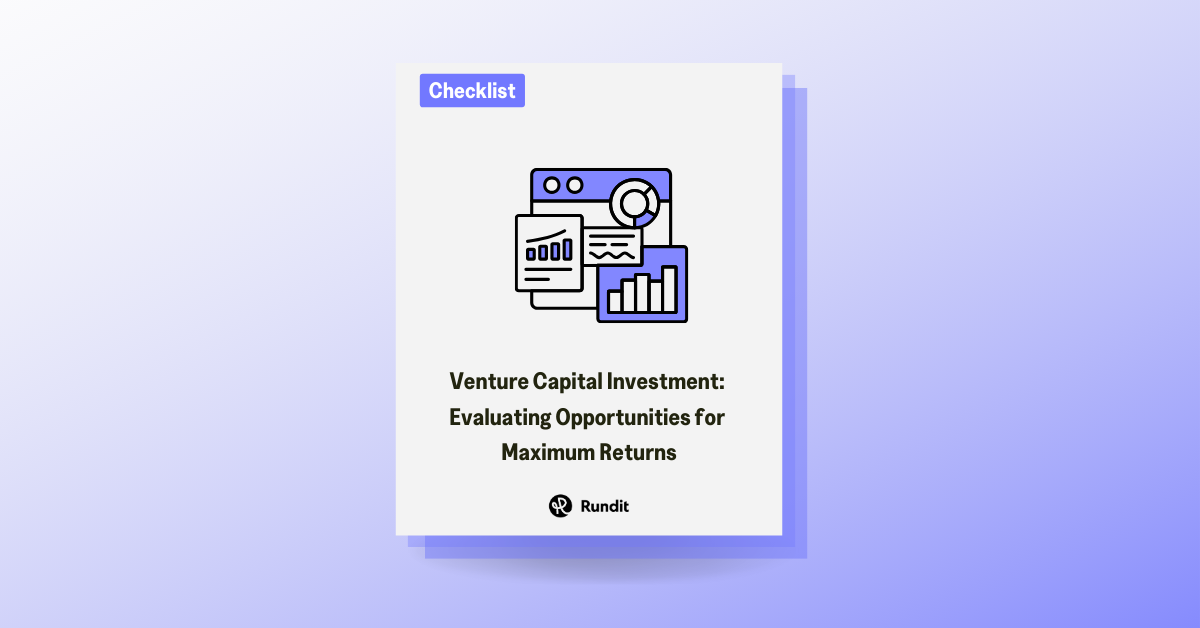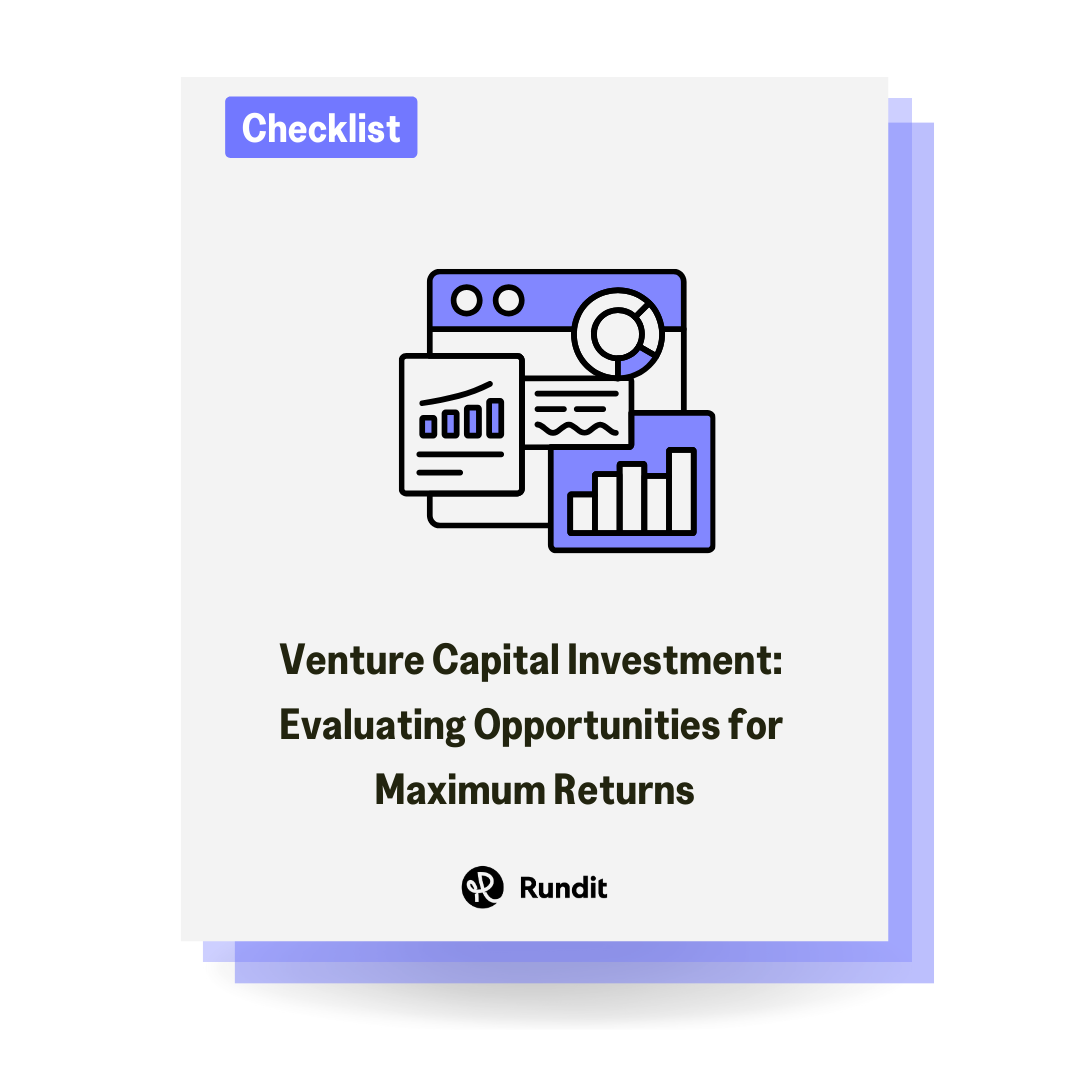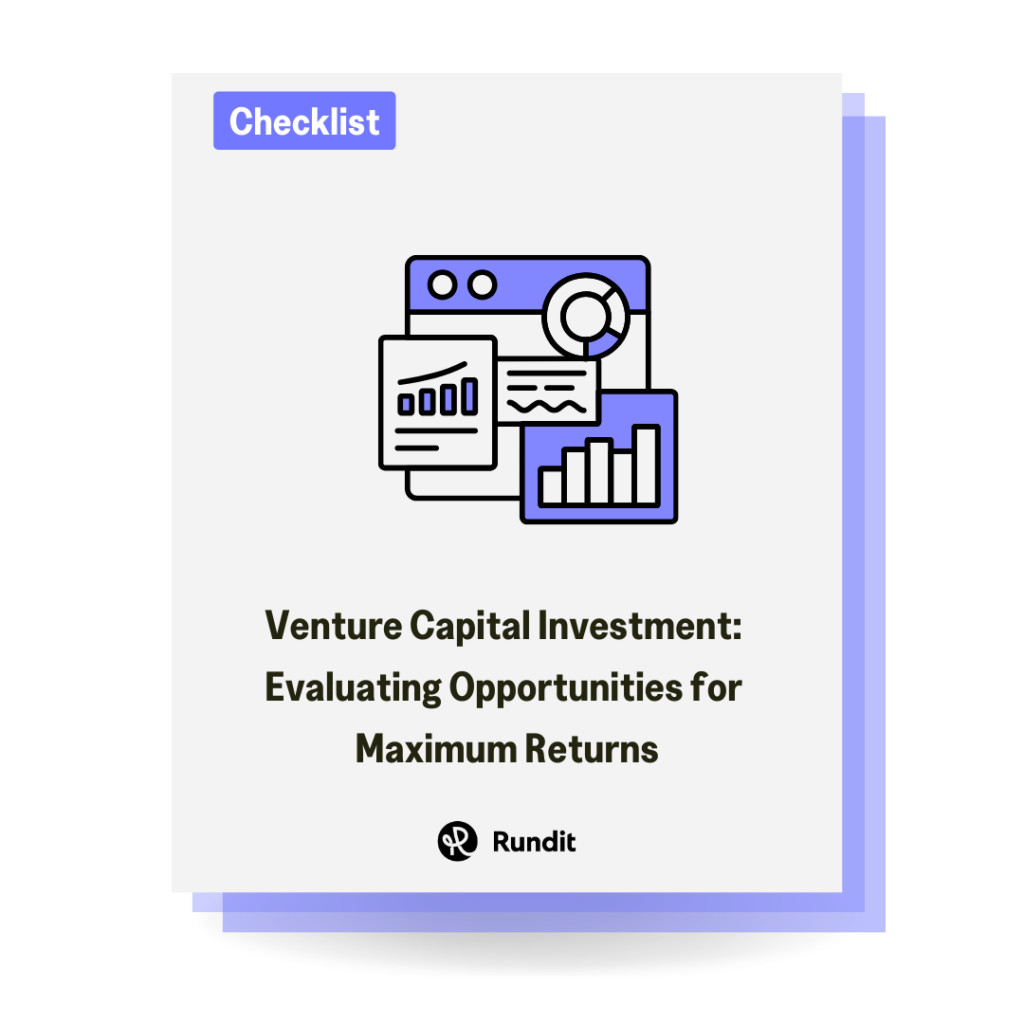
Table of Contents
Evaluating investment opportunities for maximum returns is a critical process for venture capital firms aiming to identify and capitalize on high-potential ventures. This involves a thorough analysis of various factors including legal and compliance issues, market dynamics, business models, financial health, product or service uniqueness, team capabilities, and risk factors.
Ready to dive in? Download our checklist “Venture Capital Investment: Evaluating Opportunities for Maximum Returns”!

Market Size and Growth Potential: Evaluating investment opportunities involves understanding the total addressable market (TAM) and its growth trajectory. For example, the global renewable energy market’s TAM is projected to exceed $1.5 trillion by 2025, with a compound annual growth rate (CAGR) of 6.1%. The cloud computing market, valued at $445 billion in 2021, is expected to grow at a CAGR of 16.3%, driven by digital transformation and remote working trends. These figures underscore substantial growth potential in large and expanding markets.
Market Trends and Dynamics: Identifying investment opportunities requires tracking key market trends and dynamics. The rise of the Internet of Things (IoT) improves data collection and analytics. Sustainability trends are driving innovations in green technologies and eco-friendly products. Market disruptions, like the COVID-19 pandemic, have accelerated digital transformation and e-commerce growth, emphasizing the need for business agility and adaptability.
Competitive Landscape: In assessing investment opportunities, understanding the competitive landscape is crucial. Leading companies like Tesla dominate the electric vehicle (EV) market with innovative technology and strong brand loyalty.
However, competitors like BYD and traditional automakers such as Volkswagen and General Motors are expanding their EV offerings. Competitive advantages arise from innovation, economies of scale, brand reputation, and regulatory compliance. Analyzing these factors through SWOT analysis helps in strategic planning and identifying strengths, weaknesses, opportunities, and threats.
Revenue Model: A company’s revenue model outlines how it generates income. Common models include:
Subscription: Customers pay a recurring fee for continuous access to a product or service (e.g., Netflix, SaaS platforms). Transactional: Revenue is earned per transaction or sale (e.g., e-commerce sites like Amazon).![]()
![]()
Freemium: Basic services are provided for free, while premium features are available for a fee (e.g., Spotify, LinkedIn).![]()
Scalability: Scalability assesses a company’s ability to grow its operations and revenue without a proportional increase in costs. Scalable models leverage technology and efficient processes to expand quickly. For instance, software companies can add users with minimal additional costs, thanks to cloud infrastructure and automated systems.
Customer Acquisition and Retention: Effective strategies for acquiring and retaining customers are crucial for long-term success and identifying investment opportunities. This includes optimizing the customer lifetime value (CLV) and managing customer acquisition costs (CAC). Key strategies involve:
Current Financials: Analyzing a company’s financial health involves reviewing its income statements, balance sheets, and cash flow statements:
Income Statement: Highlights revenue, expenses, and profitability over a specific period. Balance Sheet: Provides a snapshot of assets, liabilities, and shareholders’ equity.![]()
![]()
Cash Flow Statement: Details cash inflows and outflows, indicating liquidity and operational efficiency.![]()
Burn Rate and Runway: The burn rate measures how quickly a company spends its cash reserves:
Monthly Burn Rate: Calculated by subtracting monthly operating expenses from revenue. For instance, if a company spends $500,000 monthly and generates $200,000 in revenue, its burn rate is $300,000.
Runway: Indicates how long the company can operate before needing additional funding. It’s calculated by dividing current cash reserves by the monthly burn rate. For example, with $3 million in reserves and a $300,000 burn rate, the runway is 10 months.
Funding History and Capital Structure: Analyzing funding history involves examining past funding rounds and valuations:
Funding Rounds: Details the amounts raised, key investors, and terms of investment (e.g., Seed, Series A, B, etc.). Valuations: The company’s worth at each funding round.![]()
![]()
Capital Structure: Reviews equity distribution among founders, employees, and investors as detailed in the cap table, highlighting ownership stakes and potential dilution effects.![]()

Unique Value Proposition: The unique value proposition (UVP) identifies what sets a product or service apart from competitors:
Differentiation: Highlighting unique features, benefits, or capabilities that competitors lack.![]()
Customer Value: Clearly articulating how the product solves customer pain points better than alternatives. Competitive Advantage: Emphasizing strengths that create barriers to entry and foster customer loyalty.![]()
![]()
Product-Market Fit: Product-market fit determines if a product meets customer needs effectively:
Market Validation: Evidence of demand through customer feedback, adoption rates, and market traction.
Problem-Solution Fit: The extent to which the product addresses a significant pain point or solves a critical problem. Scalability: Potential to expand market reach and revenue without sacrificing effectiveness.
Development Stage: Assessing the product’s development stage and future roadmap is crucial:
Stage: Whether it’s in ideation, prototype, beta testing, or commercial launch.![]()
Roadmap: Plans for enhancing features, expanding market segments, or iterating based on user feedback and market trends.
Risk Assessment: Identifying challenges like technical hurdles or competitive pressures, and mitigation strategies.
Founders and Key Executives: Evaluate the founding team and key executives based on their industry experience, educational background, and previous successes or failures in similar ventures. Assess their leadership qualities, ability to innovate, and strategic decision-making skills. A strong track record of execution and adaptability to market changes are crucial indicators of their capability to drive company growth and navigate challenges effectively.
Advisory Board and Mentors: Evaluate advisors and mentors based on their industry expertise, track record of success, and network connections. Assess their ability to provide strategic guidance, open doors to opportunities, and mitigate risks. The relevance of their experience to the company’s goals and challenges is critical, as is their reputation within the industry for shaping successful ventures and supporting sustainable growth.
Team Dynamics and Culture: Assess company culture by observing values, norms, and behaviors that shape interactions and productivity. Evaluate team dynamics based on collaboration, communication effectiveness, and conflict resolution. A positive and inclusive culture fosters innovation and employee satisfaction, which is crucial for maintaining high performance and achieving organizational goals in a cohesive and motivated team environment.
Intellectual Property: Verify the presence and strength of intellectual property (IP) protections such as patents, trademarks, copyrights, and trade secrets. Evaluate their scope, validity, and potential infringement risks to safeguard innovation and market position.
Regulatory Environment: Understand the regulatory landscape relevant to the industry, including compliance requirements, permits, licenses, and industry standards. Assess potential impacts on operations, market entry barriers, and strategies for maintaining regulatory compliance to mitigate legal risks.
Legal Structure and Governance: Review the company’s legal structure, including its incorporation status, bylaws, shareholder agreements, and governance policies. Ensure alignment with legal obligations and best practices for corporate governance, transparency, and accountability, which are crucial for investor confidence and long-term sustainability
Market Risks: Identify risks associated with market acceptance, competition, and economic conditions. Market acceptance risks include slow adoption rates or changes in customer preferences. Intense competition can erode market share or pressure pricing. Economic downturns or regulatory changes may also impact demand and profitability, necessitating adaptive strategies and market diversification.
Operational Risks: Assess operational risks concerning execution, supply chain disruptions, and technological failures. Execution risks involve challenges in delivering products or services on time and within budget. Supply chain disruptions, such as raw material shortages or logistics issues, can disrupt operations. Technological risks encompass cybersecurity threats or outdated infrastructure affecting efficiency and customer trust.
Financial Risks: Evaluate financial risks related to funding needs, stability, and exit scenarios. Funding risks include reliance on external investment or debt financing amid market volatility. Financial stability risks involve cash flow management and profitability in adverse scenarios. Exit risks pertain to challenges in achieving liquidity through mergers, acquisitions, or public offerings. Mitigating these risks involves robust financial planning, contingency measures, and strategic partnerships to bolster resilience and sustain long-term growth objectives.
Exit Opportunities: Identify potential exit strategies such as initial public offerings (IPOs), strategic acquisitions, or management buyouts. Assess the feasibility and attractiveness of each exit option based on market conditions, investor interest, and company growth trajectory.
Comparable Exits: Analyze exit outcomes of similar companies to gauge achievable multiples and investor expectations. Evaluate factors such as industry trends, company size, and market sentiment that influence valuation and exit strategies.
Timeline to Exit: Estimate the time frame for a potential exit, considering market readiness, regulatory approvals, and internal readiness. Align exit timing with strategic milestones and investor expectations to optimize return on investment (ROI) and capitalize on favorable market conditions. Strategic planning and flexibility in execution are critical to navigating uncertainties and maximizing shareholder value during the exit process.
Background Checks: Perform comprehensive background checks on founders and key executives to verify credentials, past achievements, and any potential legal or reputational issues. This helps ensure alignment with company values and ethical standards.
Reference Checks: Engage with current and former employees, customers, and partners to gather insights into the company’s operational integrity, leadership effectiveness, and customer relationships. References provide valuable perspectives on reliability, performance, and trustworthiness.
Third-Party Audits: Consider financial and technical audits conducted by independent third parties to validate financial statements, operational efficiency, and compliance with industry standards. These audits offer an objective assessment of risks, strengths, and areas for improvement, enhancing transparency and confidence in business operations.
Valuation and Ownership: Evaluate the proposed valuation based on market comparable, financial performance, and growth potential to determine fairness and alignment with industry standards. Assess the percentage of ownership offered to investors against the funding raised and its implications on control and decision-making.
Term Sheet and Conditions: Review the term sheet comprehensively, focusing on key provisions such as liquidation preferences, voting rights, board seats, and anti-dilution protections. Clarify terms related to governance, investor protections, and exit scenarios to ensure clarity and alignment of expectations.
Alignment of Interests: Ensure alignment of interests among investors, founders, and stakeholders by establishing mutual goals, incentives, and accountability mechanisms. Promote transparency, open communication, and shared strategic vision to foster trust and collaboration throughout the investment lifecycle. This alignment enhances operational efficiency, mitigates conflicts, and supports sustainable growth and value creation for all parties involved.
Venture Capital Research—Investor Preferences and Success Factors of Start-ups

At Rundit, we understand the importance of streamlined portfolio management and efficient LP reporting in the venture capital world. Our platform is designed to support the seamless flow of data from the back office to the front office, enhancing your decision-making process with unparalleled transparency and efficiency.
With Rundit, you can access your portfolio data all in one place, eliminating the need for cumbersome spreadsheets. Our solution offers automated dashboards and interactive portfolio reports, enabling your team to manage investments in a modern and efficient manner.
Interested? Feel free to book a call with us here – Talk to Sales